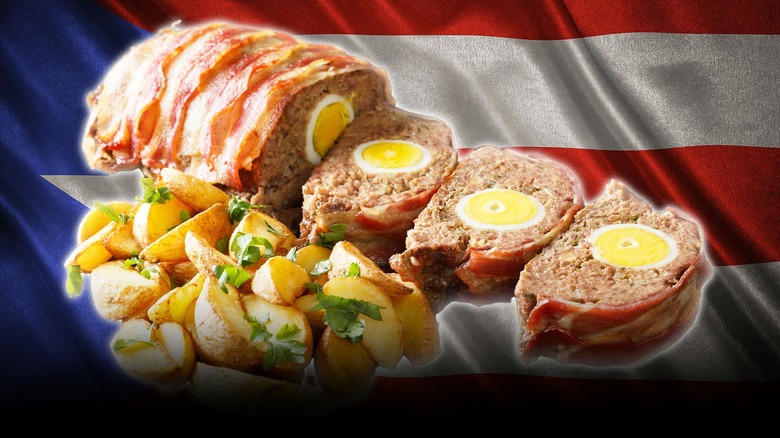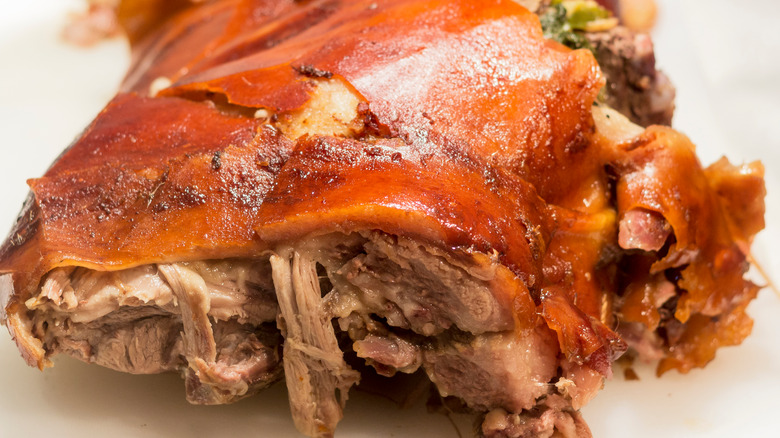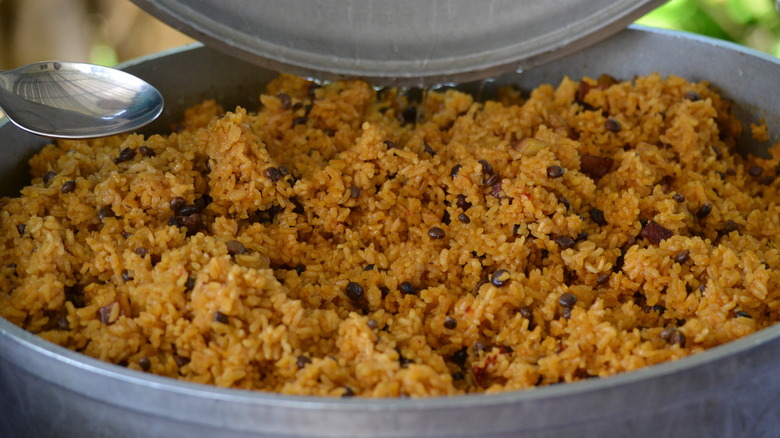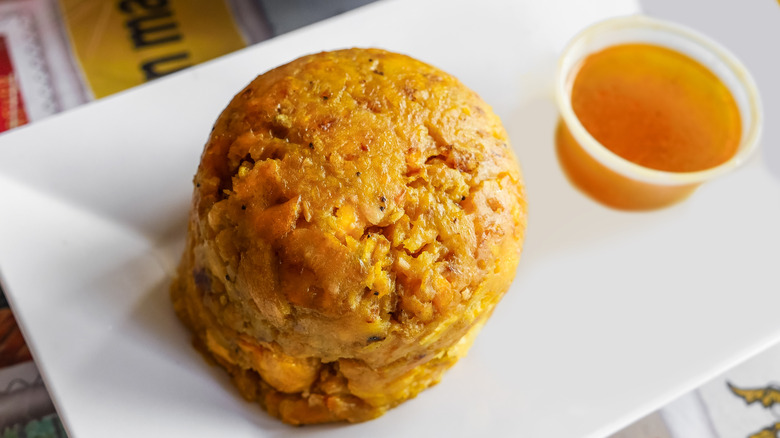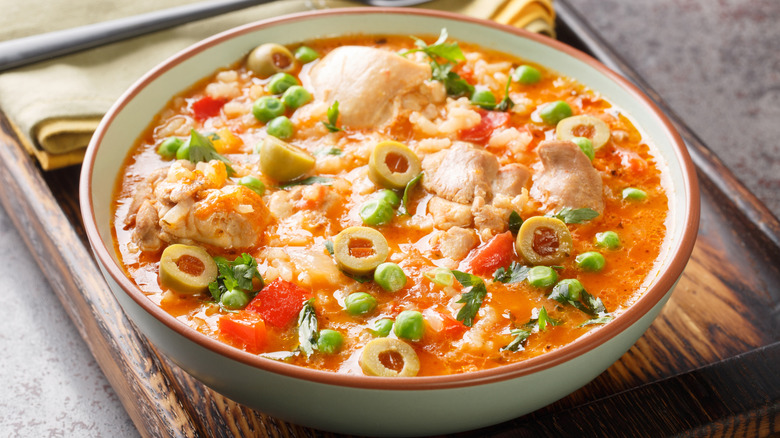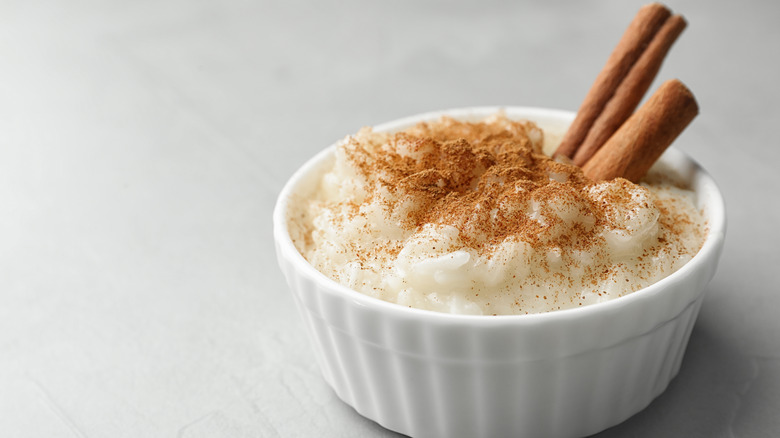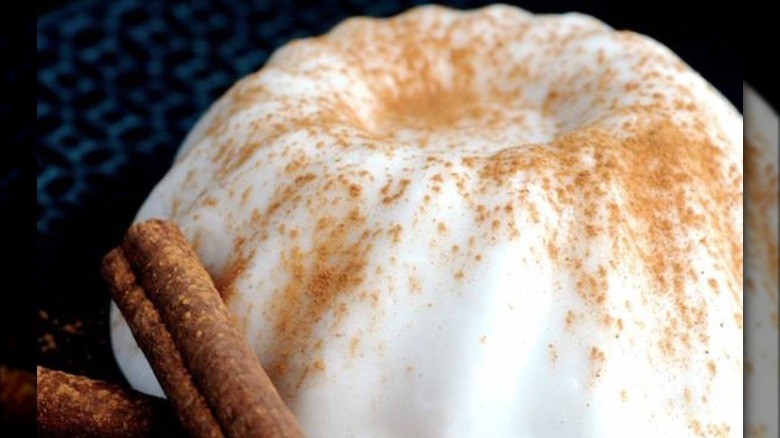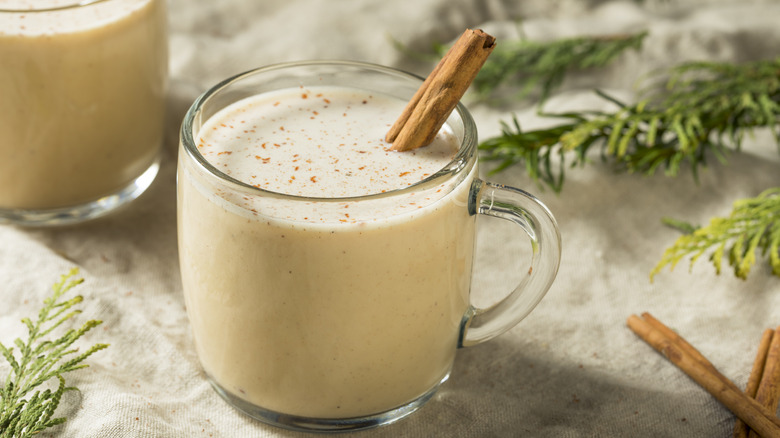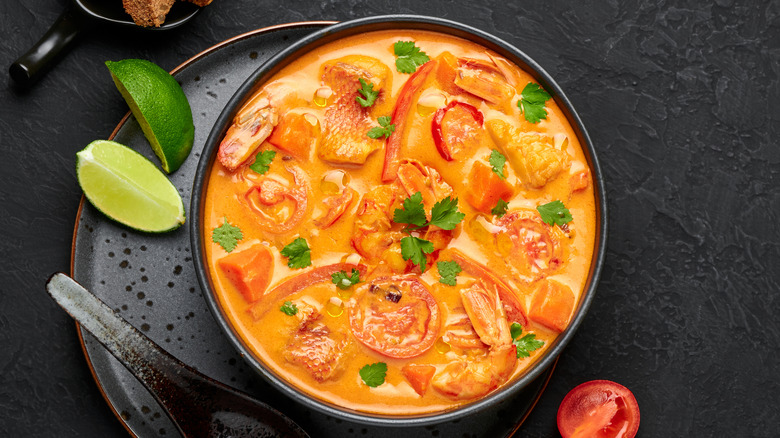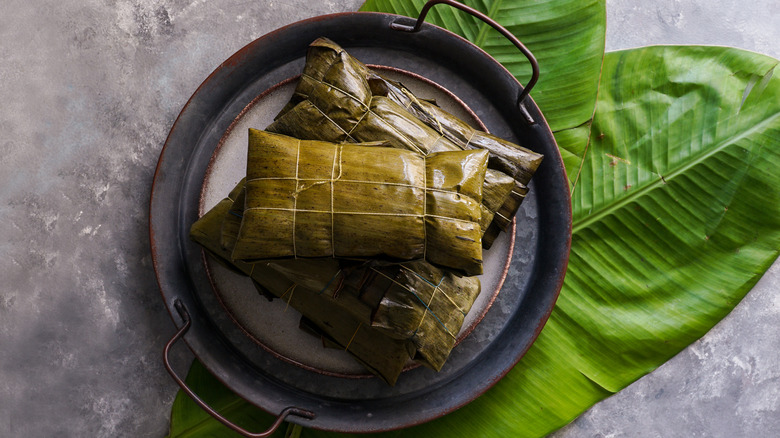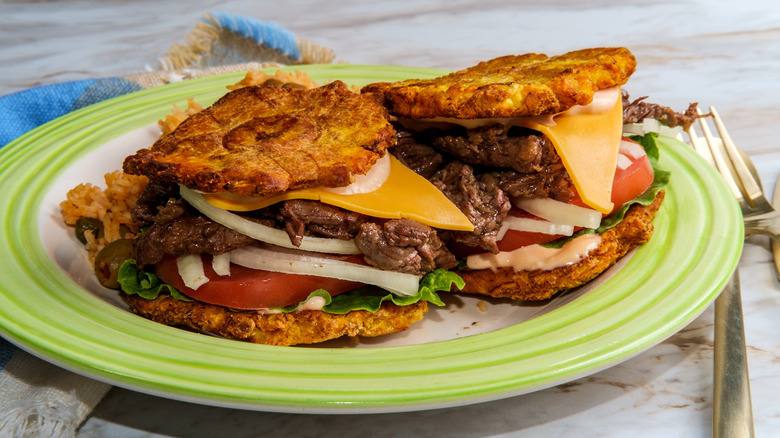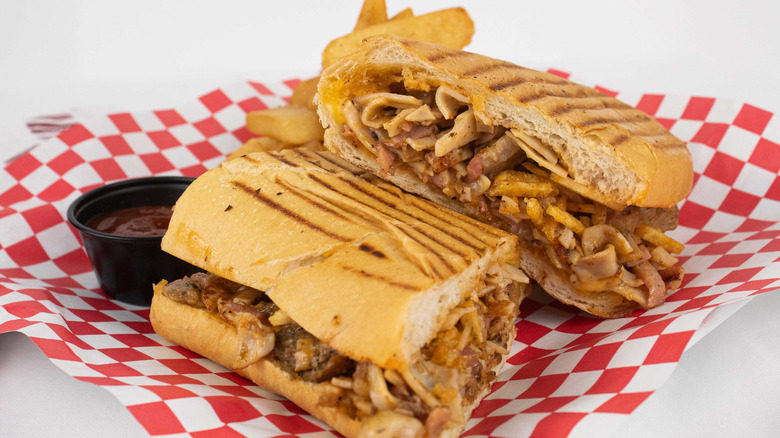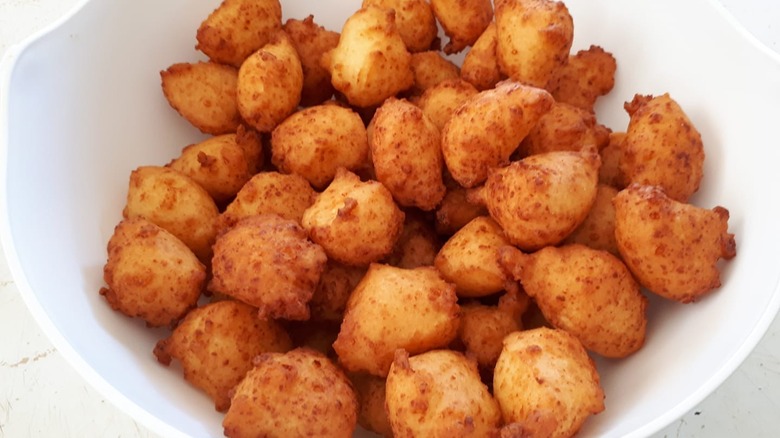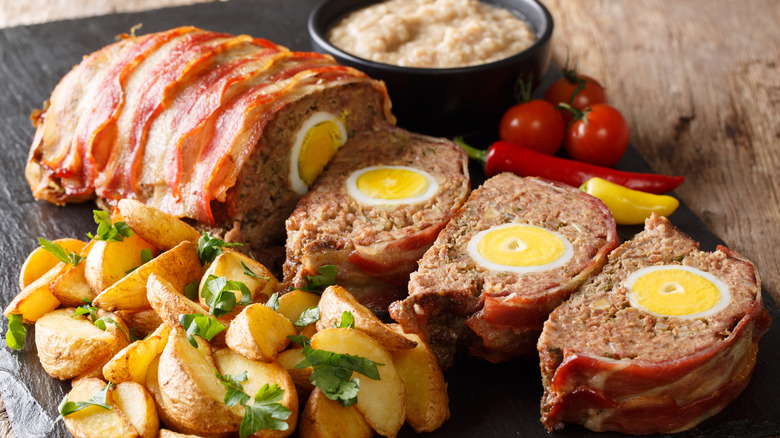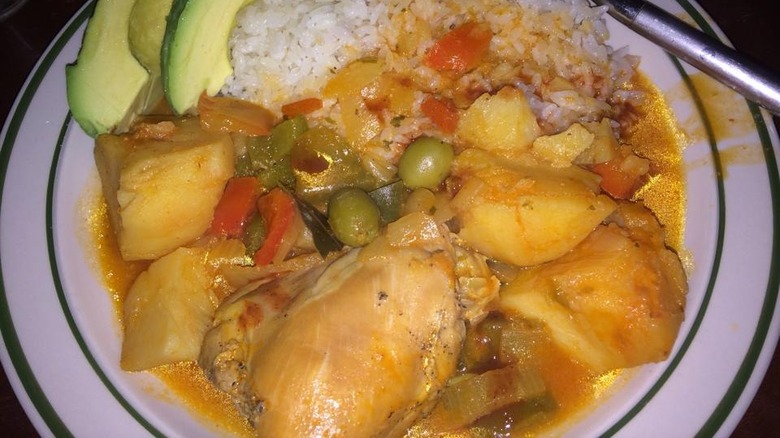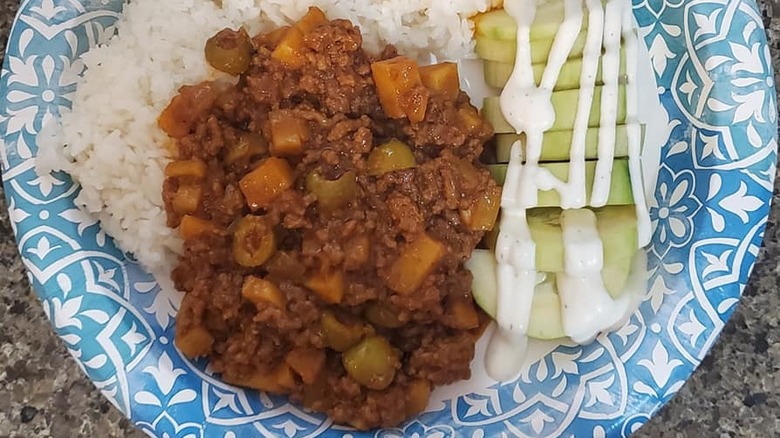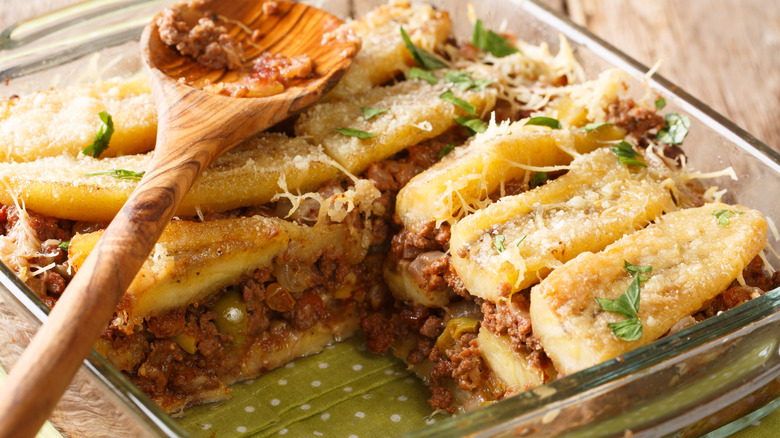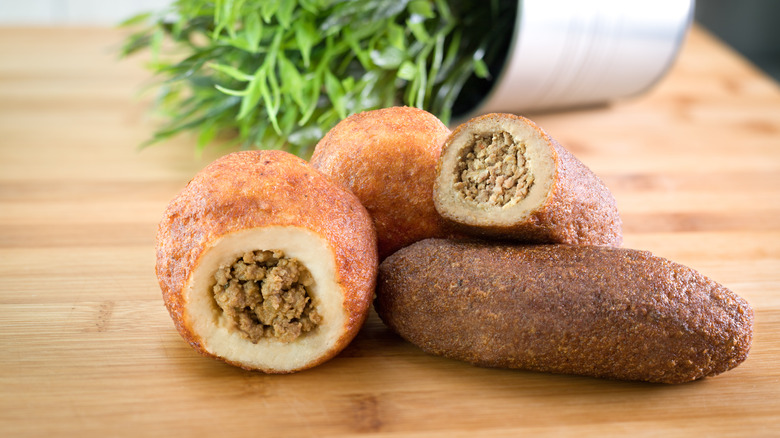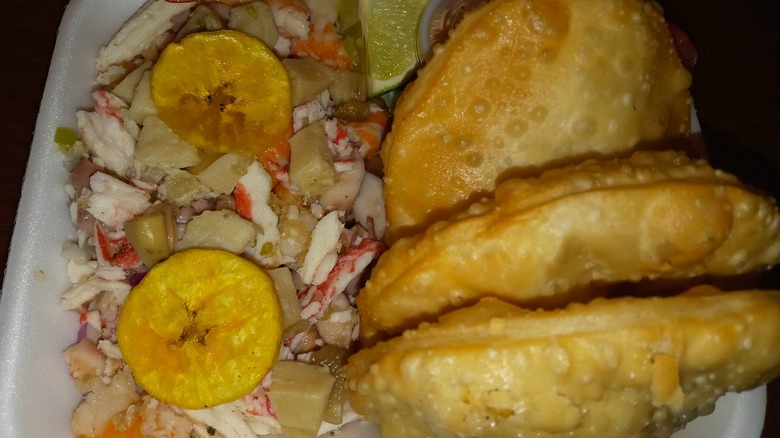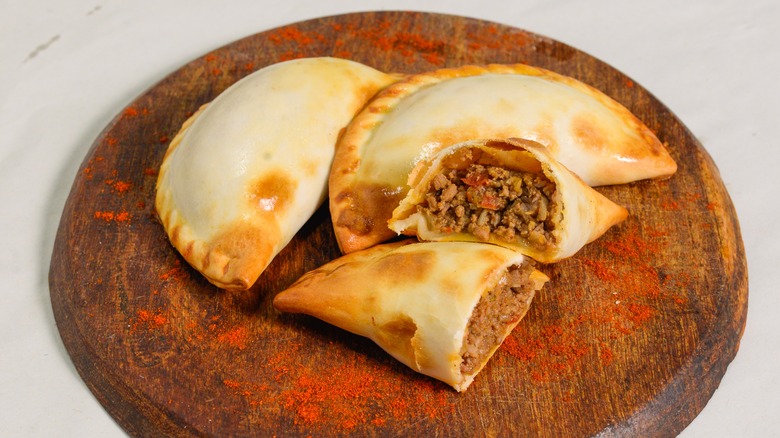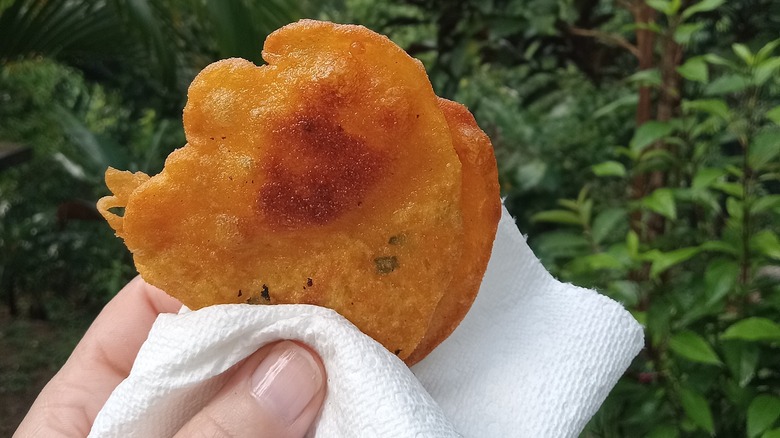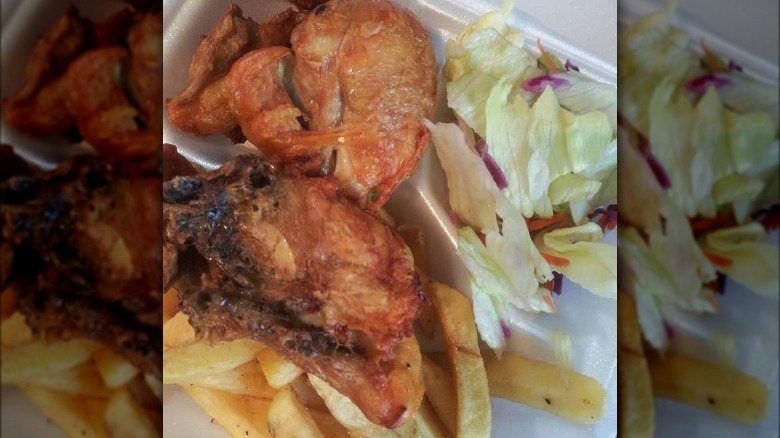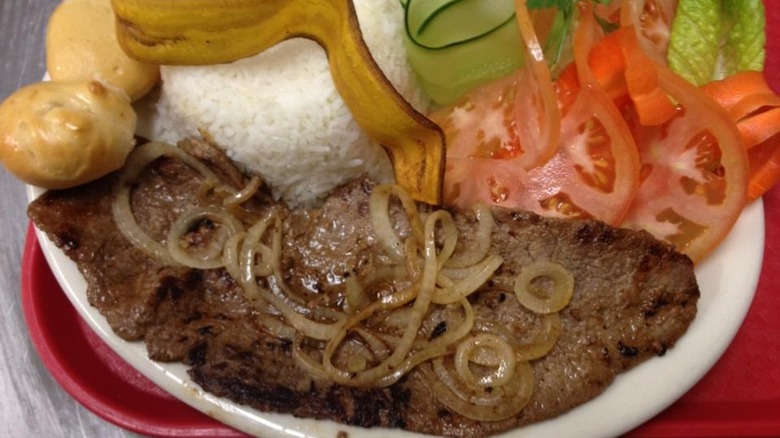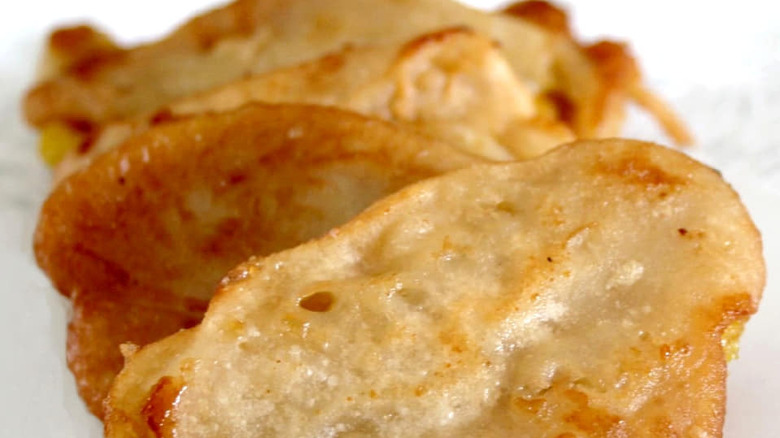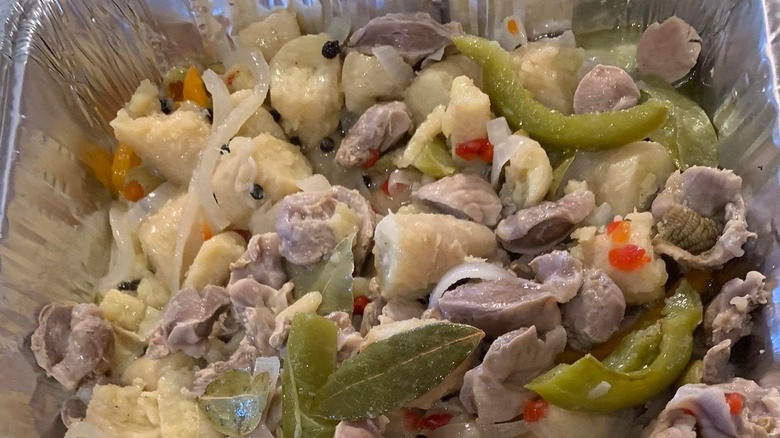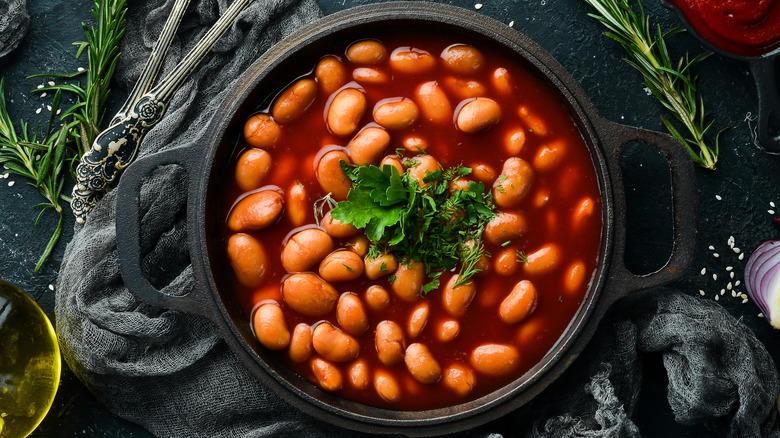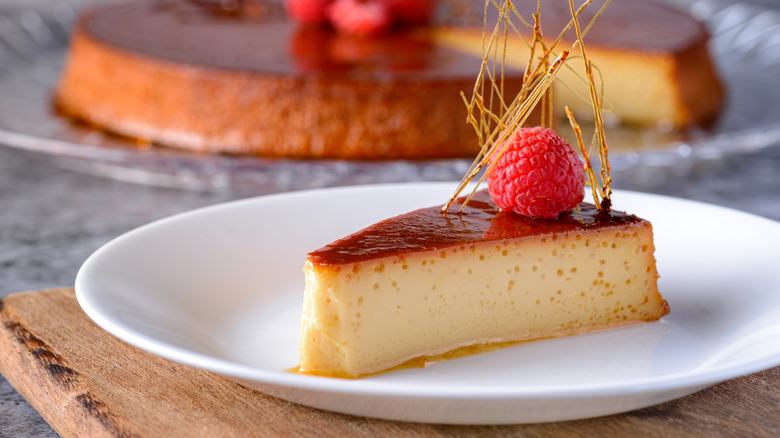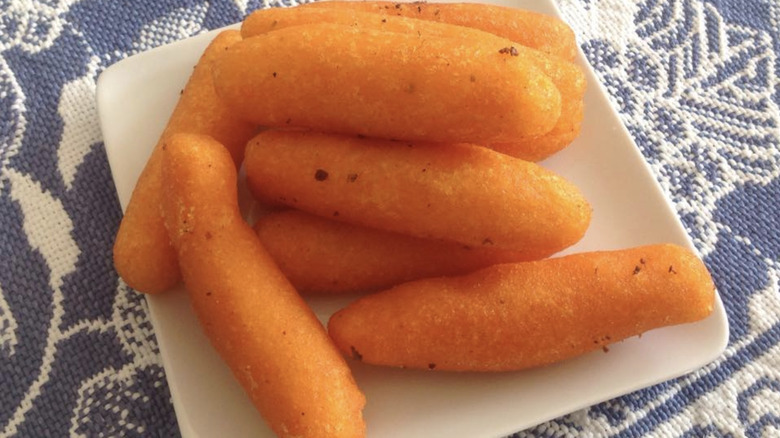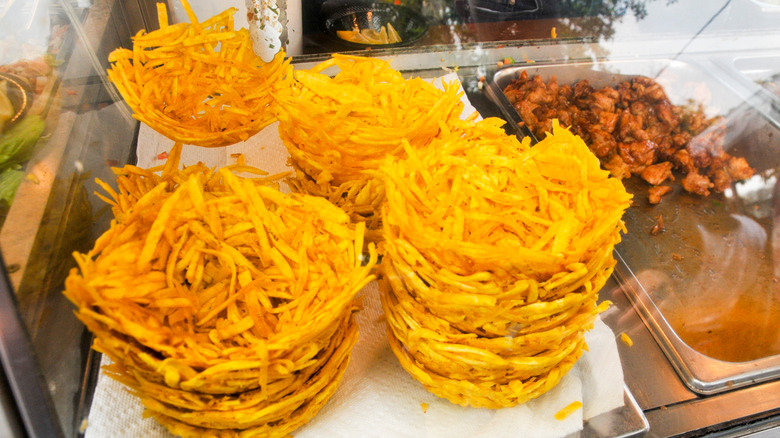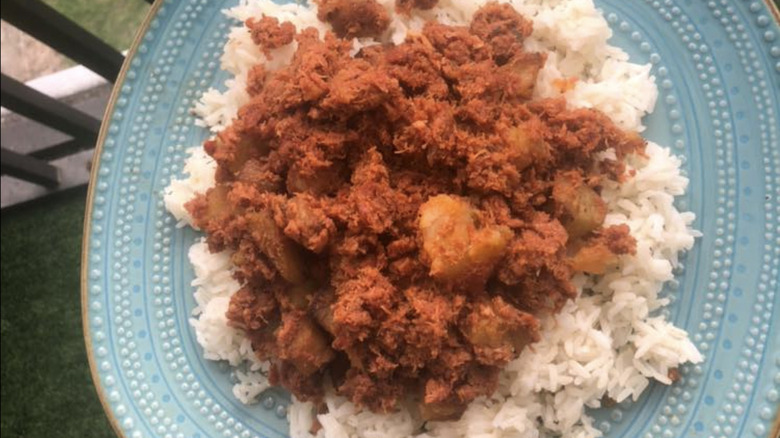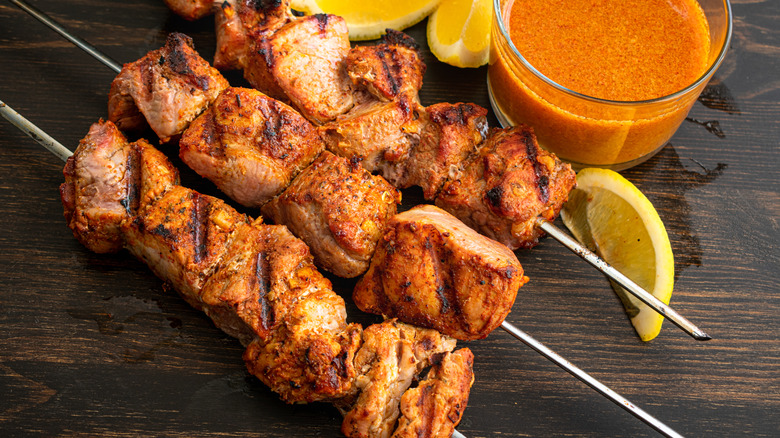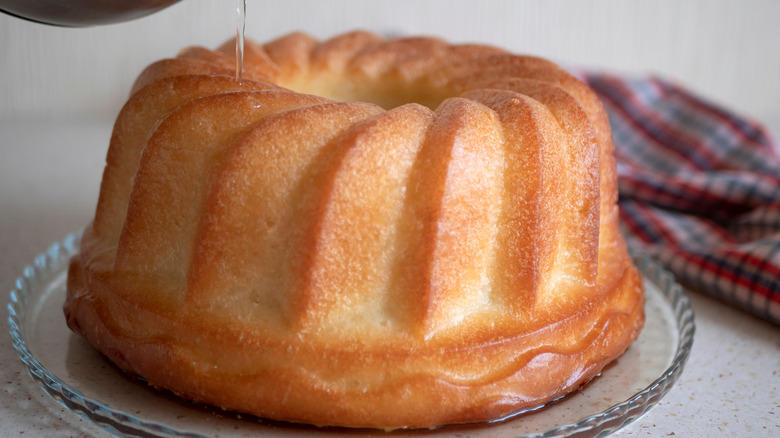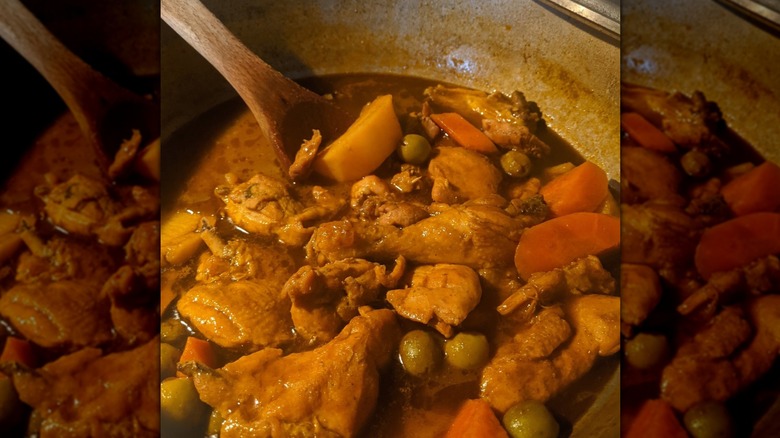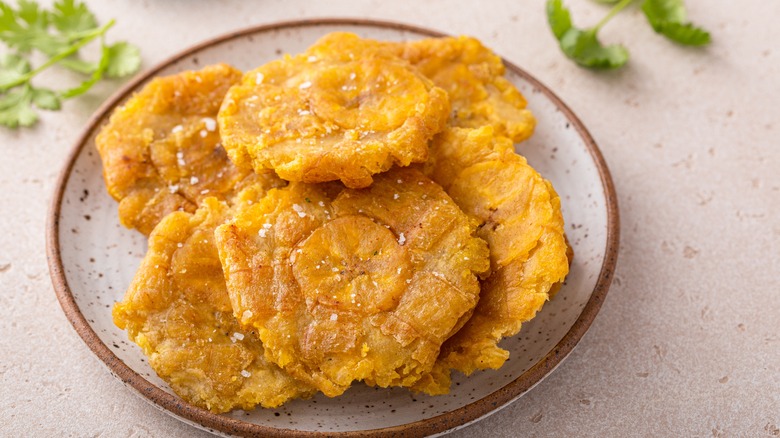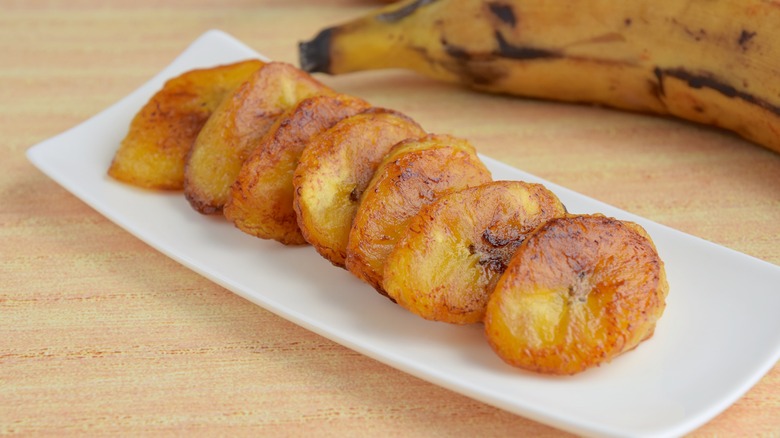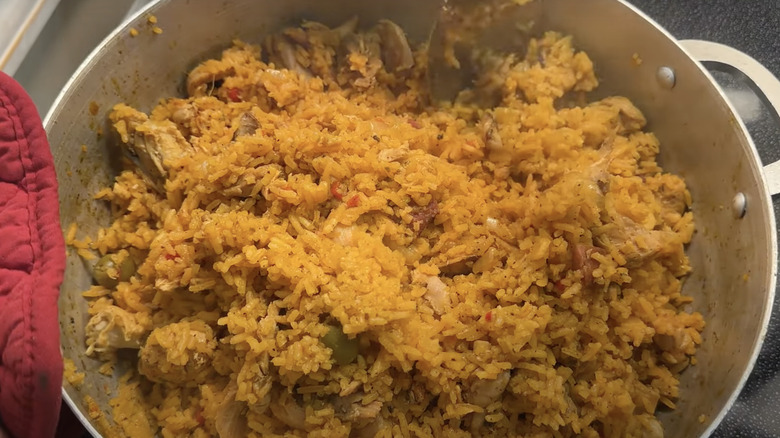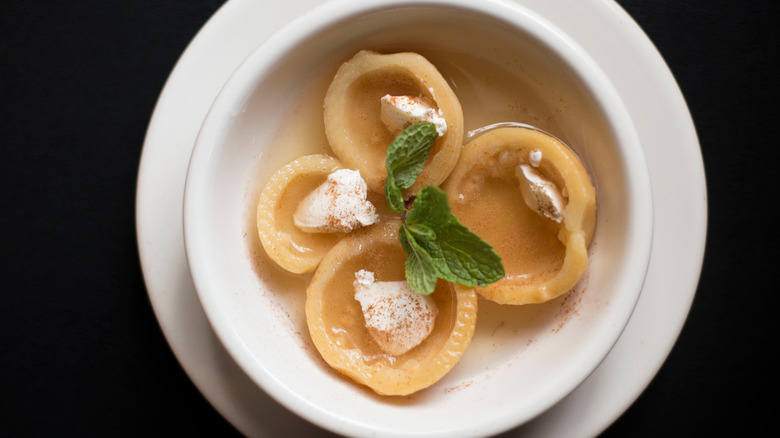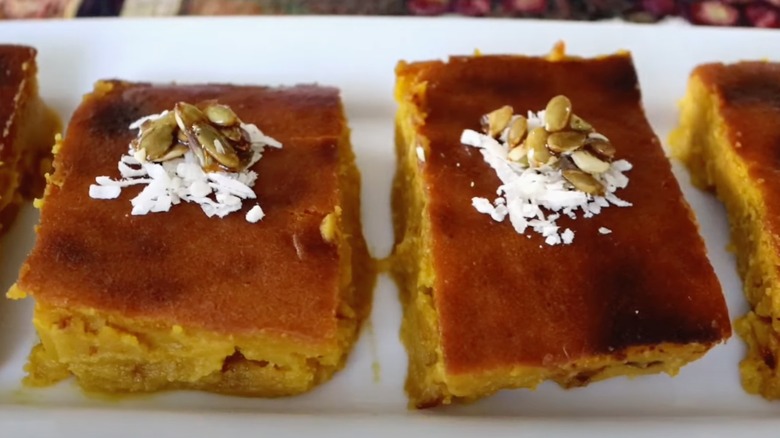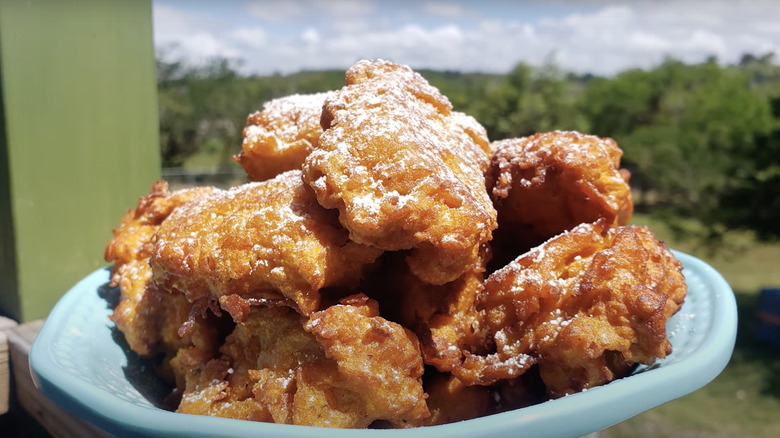42 Popular Puerto Rican Foods You Have To Try At Least Once
We may receive a commission on purchases made from links.
Puerto Rican cuisine, known by locals (Boricuas) as cocina criolla, is a culinary hybrid as complex as the island's history. It originated with Puerto Rico's indigenous residents, the Taínos, who farmed the land and gathered seafood from the island's bountiful coastline. The Spanish who conquered the country brought their own ingredients like wheat, domesticated animals, rice, and olive oil. The Spanish cultivated large sugarcane plantations, bringing enslaved Africans to do the hard, grueling work. The African laborers added more ingredients and cooking techniques to Puerto Rico's cuisine. Since Puerto Rico has been an American territory for the past century, American food traditions have been added to the mix as well.
All of these diverse influences have turned Puerto Rican food into an exciting, deeply-rooted cuisine. Techniques and knowledge from all around the world, combined with a tropical climate that's great for growing many different ingredients, have produced an array of delicious dishes that you absolutely need to try. This list goes over some of the most popular Puerto Rican foods, but you could spend a lifetime eating in the territory without running out of foods to try.
1. Pernil
Pernil is the Boricua version of lechon, Latin American-style roast pork. Pernil is a staple on Puerto Rican tables at Christmas, but you can also get it from restaurants and food stalls throughout the year. Pernil also shows up as an ingredient in other dishes, like sandwiches. It's traditionally made with a whole suckling pig, but you can also roast any large chunk of skin-on pork if you want to replicate the pernil experience in your home kitchen.
The key to pernil's incredible flavor is a marinade called mojo that's made out of minced garlic, oregano, oil, adobo seasoning, and sazón. These last two ingredients are spice mixes that are ubiquitous in Puerto Rican cooking. You can make them yourself if you have the time, but there's no shame in the store-bought Puerto Rican seasoning blends – like those from Healthy Rican – which are used by legions of home cooks. Once the pig is roasted, the most desirable part is the crispy skin, known as cuerito. If you're serving pernil at home, make sure everybody gets a piece of the skin so you don't offend any of your guests.
2. Arroz con gandules
Almost every culture has some kind of rice and beans dish. Whether it's South Asian pilaf, Cajun red beans, or Central American gallo pinto, this comforting combo has won over fans across the globe. It's easy to see why; beans and rice are cheap, shelf-stable, and nutritious, delivering all the essential amino acids as well as fiber, iron, and other nutrients.
The Puerto Rican iteration of this dependable formula uses gandules, a type of legume originally grown in India that's sometimes referred to as "pigeon peas" in English. It uses a flavor base that you'll see frequently in Puerto Rican dishes: sofrito, sazón, and achiote oil, which combine with canned tomato to give the rice in this dish a distinctive orange-red color and complex flavor. Arroz con gandules is often made with pork, but you can leave out the meat for a vegetarian version. Chopped green Manzanilla olives add some pretty color and briny acidity to counter the dish's starchiness.
3. Mofongo
Puerto Rico is a country that has endured several waves of colonization over the centuries, with each new group of people adding their own ingredients and techniques to the island's cuisine. Mofongo originated among slaves of African descent brought to Puerto Rico by the Spanish colonizers. It's descended from fufu, a West African dish made by pounding tubers like yam or cassava into a paste.
Mofongo trades African ingredients for ones that were available in Puerto Rico, swapping out plantain for yam and adding pork and garlic. Although it is a starchy side dish eaten to accompany other foods, it brings a lot of flavor and richness in and of itself, combining fried plantains, pork skin or bacon, and garlic into a rich mash. Mofongo got its start in Puerto Rico, but it has spread to other countries as well, with Cubans and Dominicans making their own spins on the dish.
4. Asopao de pollo
It seems like there is a universal human need for chicken soup. What soothes the soul (or possibly a hangover) better than a steaming bowl of brothy chicken with some rice or noodles floating around in it? Puerto Rican chicken soup, asopao de pollo, hits all those comforting notes while also packing some serious flavor. Some recipe combines bone-in chicken pieces with ham, adobo, sofrito, tomatoes, capers, and Manzanilla olives for an unforgettable experience. The balance of saltiness, acidity, savoriness, and herbaceousness will put any plain Jane chicken noodle to shame.
Asopao plays a starring role in a Puerto Rican form of partying called a parranda. It's somewhat similar to the English traditions of caroling or wassailing in that groups of singers go from door to door begging for refreshments. Unlike the tamer wassailing, however, parranda happens late at night, and the group of singers, or parranderos, ritualistically "kidnaps" each household they visit, bringing them along to harass the next house. Traditionally, asopao de pollo was the food of choice for parranda because you could prepare it ahead of time and reheat it when you were rudely thrust out of bed. While the chicken variety is most popular, asopao in general happens to be Puerto Rico's national soup.
5. Arroz con dulce
Literally translated to "rice with sweetness," arroz con dulce is the Boricua answer to rice pudding. It brings a pop of Caribbean flavor to what can often be a bland, starchy mush, adding coconut milk, cloves, canela (Mexican cinnamon), and fresh ginger to the rice as it cooks. As with many other rice dishes, soaking the grains before cooking ensures that every grain is moist, creamy, and perfectly done. It's recommended to soak for at least three hours, but you can go for up to a few days. Unlike many American and European rice pudding recipes that rely on dairy for creaminess, arroz con dulce is vegan. It's also a good dessert option for people who can't eat gluten.
You can eat arroz con dulce hot and fresh from the pot, but it's more traditional to eat it chilled. It solidifies when it's cold, allowing you to cut it into tidy squares for serving.
6. Tembleque
Tembleque is known as Puerto Rican coconut pudding, but it's not very much like the stuff you get in a cup for school lunch. Instead, it's more like the mid-century Jell-O molds that your grandma might have made, at least in texture. It's named after the Spanish word for "shake," temblor, and it definitely lives up to its name when it pops out of the mold in all its jiggly glory. Unlike Jell-O, which is thickened with animal gelatin, tembleque uses cornstarch, so vegans and vegetarians can eat it. To make it, you combine coconut milk with sugar, seasonings, and cornstarch and cook in a saucepan until the starch gelatinizes. Then you pour the hot mixture into a pan and chill to set.
Flavor-wise, tembleque tastes festive and tropical, with the sweet flavor of coconut harmonizing with lime, cinnamon, and vanilla. If you want to achieve a beautiful snowy-white tembleque, try to find additive-free coconut milk such as Nature's Greatest Foods.
7. Coquito
There's just something about the winter holidays that makes people want a thick, creamy way to drink alcohol. In English-speaking parts of the world, drinkers suddenly develop a taste for eggnog in December. Chileans mix coffee, sugar, milk, and pisco in their home kitchens to make cola de mono. Puerto Rican cooks, however, whip up creamy coquito around Christmas time.
Although coquito is certainly very rich, it's a little lighter than eggnog because it doesn't have eggs. The creamy component is a mixture of sweetened condensed milk, coconut cream, and coconut milk. For those who want it boozy, rum is the traditional option. A hefty dose of sweet wintery spices like cloves, nutmeg, and cinnamon make it taste like Christmas. If you're looking for something to serve at a holiday party this year, coquito is a real crowd-pleaser. You could even make little bottles of it to give to friends.
8. Caldo Santo
This is another holiday specialty but for Good Friday instead of Christmas. Caldo santo, or "holy stew," is made from fish, so it abides by Catholic proscriptions against eating land animals on Good Friday. Like mofongo, this dish shows an African influence on its flavors and ingredients. For most of its history, this dish was little known outside of the region surrounding the city of Loíza, but its appearance in Emma DuPrey de Sterling's seminal 2004 cookbook "Cocina Artesanal Puertorriquena" made the soup significantly more well-known and popular.
Caldo Santo is typically made with a mix of seafood that includes shrimp, bacalao (salted cod), and fresh snapper. The fish is simmered with root vegetables and plantain balls in a broth of coconut milk, achiote oil, coriander, peppers, and garlic. The flavor of the seafood enriches the broth with a briny flavor, and the achiote oil turns it a beautiful orange color.
9. Pasteles
The word "pastel" translates to "pie" in Spanish, but Puerto Rican pasteles aren't very pie-like. Instead, they're much more reminiscent of Mexican tamales, although with some key differences. Like with tamales in Mexico and the American Southwest, Puerto Rican families like to have big pastele-making parties during the Christmas season, dividing the laborious process amongst many family members. Also, like tamales, pasteles are traditionally prepared with a slow-cooked pork filling that's wrapped in masa and steamed in a leaf. Other than that, they're pretty different from each other.
Rather than the corn-based masa in Mexican tamales, the masa for pasteles is made from green plantains and a variety of root vegetables. Pasteles are also steamed in banana leaves instead of corn husks. While the pork filling in pasteles might look like tamale filling, its use of sofrito, vinegar, capers, and sazón makes it taste Puerto Rican through and through.
10. Jibarito
It's unclear whether jibaritos existed under their current name until Puerto Rican restaurants in Chicago started selling them, but whether or not they originated on the island, they're a part of the Puerto Rican food canon at this point. As we've already written, the distinguishing feature of a jibarito sandwich is the "bread," which is actually a flattened, fried piece of unripe plantain. Although he didn't call them jibaritos, Puerto Rican restaurateur Jorge Munoz started serving sandwiches on plantain "bread" in the early '90s.
According to Thrillist, Juan Figueroa, a Puerto Rican chef in Chicago, read about Munoz's sandwich de platano and started making his own version, re-christened the jibarito. From there, it spread to other communities with large numbers of Puerto Ricans, like New York City and Florida. You can put almost anything inside a jibarito, but the original filling is a thin-sliced steak dressed with mayonnaise, garlic oil, lettuce, and tomato. If beef isn't your thing, you can swap it out with pork, chicken, or seafood.
11. Tripleta
Like its cousins, the po' boy sandwich and the hoagie, the tripleta started as a portable meal for working-class men. The long roll tripletas are served on allows cooks to basically shove an entire dinner onto one sandwich.
If you like Cuban sandwiches, the tripleta's combination of roast pork and ham will look familiar to you. The Puerto Rican sandwich ups the ante by adding a third meat, thinly sliced steak (bistec). The sandwich gets its name from the combination of these three meats. The meats are dressed with Swiss cheese and the standard lettuce, tomato, and onion.
The classic condiment for a tripleta is mayo-kechu, a mix of ketchup, mayonnaise, and other seasonings that's quite popular in Puerto Rico. The final topping, and the most fun one, is crispy canned shoe-string potatoes. With all the fixings, a good tripleta can be a struggle to fit inside your mouth, but it's worth the effort.
12. Almojábanas
Like many food names, "almojábanas" refers to different dishes depending on what country you're in. In Colombia, it means a kind of savory leavened roll made with a dough of corn masa flour, baking powder, and cheese that gets baked in the oven.
Puerto Rican almojábanas share some features with the Colombian variety, in that they are a round bread made with cheese. However, the Puerto Rican version is deep-fried, almost like a cheesy doughnut. It's also made with a different kind of dough that uses rice flour and wheat flour instead of masa. This kind of almojábanas is often served sweet, getting a post-fry soak in honey and brown sugar. If savory is more to your taste, you can use the same dough and frying procedure and just sprinkle with crumbled cheese instead of sugar.
13. Albondigón
Albondigón, which roughly translates to "big meatball," is like if a classic meatloaf and a Scotch egg had a baby. Some recipes use a whopping six different types of meat: ground beef, ground pork, chopped ham, ground chicken, bacon, and canned deviled ham. Move over, Arby's: There's a better Meat Mountain in town. The mixture is bound together with breadcrumbs and eggs, and then, in case there wasn't enough protein, stuffed with hardboiled eggs.
Like classic diner meatloaf, this gets a thick tomato-y glaze, although in this case, it's a step up from sticky ketchup. This is a fresh tomato sauce that's thickened with flour and flavored with bay leaf, oregano, and olives. Like some other items on this list, albondigón is popular beyond Puerto Rico, with variants between regions and even families. For example, other recipes for Colombian albondigón stuff the meatloaf with carrots and green beans in addition to the boiled eggs.
14. Fricase de pollo
"Fricase" (or "fricassee" in English) is a term for a type of meat stew. You can fricassee many different types of meat, but chicken is always a popular choice. Fricasseeing is a European technique that arrived in Puerto Rico because of Spanish and French colonists. Europeans brought fricassees to many of their Caribbean colonies, and this dish is very popular in Cuba in addition to Puerto Rico.
Fricase de pollo is somewhat similar to French coq au vin, slowly simmering chicken in a broth of red wine and aromatic vegetables. The seasoning for fricase shows a distinctly Boricua touch, however, adding tomatoes, cilantro, bell peppers, and adobo. This is a saucy dish, and it definitely needs some kind of starch, like arroz con gandules, to soak up all the juices. Of course, as a home-cooking dish, there are as many fricase recipes as there are families. Other variations add ham, vinegar, and capers for a completely different experience.
15. Picadillo a la Puertorriqueña
Picadillo is a seasoned ground beef dish that is popular in many Latin American cultures. The Puerto Rican version gets its flavor from sofrito (also known as recaíto), a mixture of culantro leaves, garlic, and peppers that are cooked down into a paste. Culantro has a similar taste to cilantro, but is more potent. Sofrito is one of the base flavors of Puerto Rican cuisine, showing up in many of the most popular dishes. You can make it at home, but there's also the jarred variety for convenience, offered by brands like Goya.
To make picadillo, you start by sautéing sofrito together with chopped peppers and onions. Next, add tomato sauce, ground beef, and olives, and cook until the meat reaches a thick but saucy consistency, sort of like Italian meat sauce. You can serve picadillo on top of white rice or use it as a component in other dishes like empanadas.
16. Pastelón
Pastelón is a plantain and beef casserole that's kind of like the Puerto Rican equivalent of lasagna. Rather than lasagna's layers of pasta, ragu, and bechamel or ricotta, pastelón stacks thin slices of fried ripe plantains and layers of picadillo, finishing off with a mixture of eggs and baking soda that holds everything together while it bakes.
That's the basic template for pastelón, but the details vary depending on who you ask. According to Simply Recipes, there's a divide between Puerto Ricans who grew up on the mainland U.S. versus those who live on the island. On the mainland, cooks tend to add mild cheese to their pastelón. In Puerto Rico, there's usually no cheese, but they do add canned French-cut green beans. Some recipes also call for raisins. Pastelón is customizable to your tastes, so whether you think raisins are gross, get icked out by green beans, or can't eat cheese, there's a pastelón for you.
17. Alcapurrias
This is another dish stuffed with picadillo. In this case, the picadillo goes inside a dough made of green plantains and yautía root. Yautía, also known as malanga, is a kind of tuber that can be cooked and eaten like a potato, dried and turned into starch, or pounded into dough (via Specialty Produce). The dough is dyed orange-gold with achiote, known in English as annatto. This common ingredient in Puerto Rican dishes originated in Central and South America. It's used more for color than texture, responsible for turning cheddar orange and butter golden. Its flavor is subtle, but it does have a certain bitter, floral character.
After stuffing with picadillo, the dough gets formed into a little cigar and then deep-fried. Alcapurrias are a popular street food on Puerto Rico's coasts, where many street stalls offer the deep-fried treats. In addition to the beef-filled variety, you can also find versions stuffed with crab or bacalao.
18. Arepas de coco
These should not be confused with Venezuelan arepas, disks of corn masa dough that are griddled and then stuffed like sandwiches. Instead, these are a type of crispy, fluffy fried bread made from white flour and coconut milk. When fried correctly, the dough puffs up, leaving a perfect little pocket for stuffing your arepas with whatever toppings you want. You can eat them by themselves as a snack, but the recipe is so plain that they taste better when they're stuffed.
Once again, you can use picadillo, but there are many other options as well. Another classic is to serve them with seafood salad, as is common at the street carts near the beach in Puerto Rico. Puerto Rican seafood salad, with its hefty kick of acidity, is somewhat similar to ceviche.
19. Empanadillas
What's better than pie? Deep-fried pie, of course. What's better than deep-fried pie? A deep-fried pie that's filled with meat that you can eat on the go! Empanadillas (also known as empanadas or pastellitos) are a type of savory or sweet hand pie that's popular all over Latin America. Think of them as the original Hot Pocket, only a million times better. They're a popular treat in bakeries on the island. The Puerto Rican version uses a wheat-based pie dough that gets fried in oil, but some variations call for baking instead of frying.
If you don't feel like making your own pastry and have access to a Latin American grocery store, you can buy pre-cut circles of dough designed for empanadillas to make your life easier. As with so many other stuffed Puerto Rican snacks, picadillo is a popular filling, but it's by no means the only option.
20. Bacalaitos
Bacalaitos are a type of fritter or pancake made from salted fish (traditionally cod, though pollock works too). The preserved fish is inedibly salty when you buy it and needs to be pre-prepped before you can use it in recipes. To prep the fish, you have to first soak it in water for six hours, changing the water at least once. Then, you need to poach the fish in more fresh water mixed with a little vinegar, which takes out even more salt and cooks the fish.
Once the fish is ready to go, you mix it with a thin pancake batter seasoned with chopped bell peppers, herbs, and sazón. The bacalaitos get shallow-fried in a skillet until crispy, golden brown, and delicious. If the labor-intensive process of prepping salted fish doesn't appeal, but you still want to taste bacalaitos, Goya makes a powdered mix that takes a lot of the work out of the process.
21. Chicharrones de pollo
In Spanish, the word "chicharrones" refers to crunchy pork rinds. Puerto Rican chicharrones de pollo is a special type of fried chicken that is so crispy that it almost mimics the texture of chicharrones. Chicharrones de pollo are common in roadside fast-food stands in Puerto Rico, where you can get them with mofongo on the side.
A few techniques set this dish apart from a standard Southern fried chicken. First off, the marinade incorporates vinegar, citrus juice, garlic, and oregano. Next, the bone-in chicken is cut into smaller pieces before breading and frying. This increases the surface area-to-volume ratio of the chicken, giving you more crunch. Third, perhaps most importantly, the chicken is fried multiple times. This technique, which is also seen in Korean fried chicken, makes the breading significantly crispier than a single fry. The Noshery's recipe calls for three separate stages of frying to achieve the ultimate crunchy exterior.
22. Bistec Encebollado
Bistec is a Spanish adaptation of the English "beefsteak," and bistec encebollado is a thin piece of steak cooked with rings of onion. The steak of choice for this dish is flank, preferably cut into thin strips. The steak is first marinated for at least a few hours and up to a couple of days in a mixture of sofrito, vinegar, sazón, adobo, garlic, oregano, and cumin. After the marinade has gotten a chance to flavor the meat, the beef is briefly seared, then braised with the leftover marinade, as well as tomato sauce, onions, more sofrito, and butter.
Once cooking is done, you're left with soft, slow-cooked steak in a thick, rich gravy with soft onions. One classic way to serve it is on a bed of simple white rice, maybe with some fried plantains on the side. You can also add bell peppers or fried eggs on top to dress it up.
23. Jibaritos Fritos
This dish should not be confused with a jibarito sandwich, with which its only commonality is that it contains a kind of fried banana. However, unlike the sandwich, which uses starchy green plantains, jibaritos fritos uses sweet baby bananas, known as guineos niños in Puerto Rico. Baby bananas are sweeter than other banana varieties. They only grow to about 3 inches long and were first cultivated in Colombia.
Guineos niños are the most sought-after bananas in Puerto Rico, prized for their superior sweetness compared to conventional bananas. They grow in the country's mountainous regions, where the elevation makes the weather a little cooler and shadier. When ripe, they're used in salads, desserts, and, of course, jibaritos fritos. This snack, also called niños envueltos, takes these tiny, sweet bananas, dips them in a wheat flour batter, and deep-fries them. They are often served sprinkled with cinnamon.
24. Guineos con mollejas en escabeche
Escabeche is any meat that is cooked and then soaked in an acidic marinade before serving. Escabeche is usually chilled for serving. This style of food has a long history, first being brought to Europe by Arab forces during the Middle Ages, who called it al-sikbaj.
Guineos con mollejas en escabeche takes this ancient technique and applies it to a mixture of green bananas and chicken gizzards. Green bananas are simply unripe conventional bananas, and gizzards, which are part of the chicken's digestive system, have a chewy texture and a robust, meaty flavor. The gizzards and bananas are boiled before mixing with oil, vinegar, bell peppers, olives, and herbs. The dish needs to sit in the fridge for at least an hour before serving in order for the seasoning mixture to properly penetrate the bananas and gizzards. Although this dish is traditionally made only with gizzards, you could substitute other cuts of chicken if you're squeamish about organ meat.
25. Habichuelas guisadas y viandas
This is Puerto Rico's version of stewed pork and beans. The base of the dish is a broth made from country ham, tomatoes, sofrito, sazón, and adobo. Pink beans simmer slowly in this broth and become soft, stewy, and delicious. Recipes for habichuelas guisadas vary, but the beans, tomato, sofrito, and pork remain constant no matter what else changes. Some versions use achiote oil to give the dish a more vibrant orange hue. Others, such as Kitchen Gidget's, add some green olives and potatoes for some variety.
Regardless of how it's dressed up, habichuelas guisadas is, at heart, a rustic, homey dish. It's made with inexpensive ingredients, but the end result is nourishing and delicious. You can serve these beans as a side dish in a more elaborate meal or simply put them on top of plain rice for an easy weekday dinner that's packed with flavor and nutrition.
26. Flan de queso
Flan is popular in many different countries. Recipes for Cuban-style flan vary in how the dessert is made and sold across Latin America. You can find multiple flavors of flan sold in Puerto Rican panaderias, including a fruity kind made with guava as well as this ultra-creamy version.
The addition of cream cheese to flan de queso changes the texture of the custard, making it reminiscent of cheesecake filling. The hint of tang from the cheese also gives flan de queso a little more depth of flavor than a plain vanilla flan.
Other than the cream cheese, flan de queso is pretty much the same as any other flan. You cook a caramel, then pour an eggy custard batter over the top. The whole thing gets baked together, then (carefully) inverted so the liquid caramel oozes over the top.
27. Sorullitos de maiz
Sorullitos de maiz, also known as sorullos or surullitos, are finger-shaped corn fritters usually filled with cheese. You can think of them as the Puerto Rican version of mozzarella sticks. They can be eaten as a snack, a breakfast food, or a side with a larger meal. Sometimes sorullitos are sweetened, but it's also common for them to have a more savory flavor profile.
This dish gives you a wonderful contrast between a crispy exterior and a gooey, cheesy filling. The specific type of cheese varies depending on the recipe. Some recommend edam or gouda, though it is possible for you can use American or sharp cheddar as well.
To make sorullitos, you first cook cornmeal with water to make cornmeal mush. Then, you either mix cheese with the cooked cornmeal dough or take small pieces of the dough and wrap them around chunks of cheese. Finally, you deep-fry your sorullitos until the outside is golden brown and the inside is molten.
28. Arañitas
Arañitas means "little spiders" in Spanish, but don't worry: No arachnids are harmed in the making of this savory fried treat. Arañitas are actually fritters made with grated and fried plantain. They're called little spiders because the crispy threads of plantain look sort of like spider legs.
This snack is made with plantains that are still unripe and green. This is when they're at their starchiest and least sweet. The process is very similar to the way you'd make hash browns with potatoes. First, you grate green plantains. Then, you squeeze them together into little lumps and fry them until crispy. The craggy outside, with all of its nooks and crannies, becomes very crunchy, while the inside stays starchy and soft.
Arañitas are often served as a side dish, but they can also be a standalone snack when served with a dipping sauce. You can go with a blend of mayonnaise and ketchup or follow this suggestion and get fancy with some cilantro aioli or cocktail sauce.
29. Quesitos
In English, quesitos means "little cheeses." They are small cigar-shaped baked treats made with puff pastry and filled with sweetened cream cheese. You can find them in panaderias throughout the island of Puerto Rico. After they're baked, they get brushed with a simple sugar syrup that adds sweetness and makes the outside of the pastry extra glossy.
The most basic filling is a simple mixture of sugar and cream cheese, but you can find quesitos in a variety of delectable flavors. Guava paste is quite popular and pairs well with cream cheese. Dulce de leche, jam, and nuts also occasionally make their way into quesitos.
If you don't have access to a Puerto Rican bakery, quesitos are easy to make at home with store-bought puff pastry sheets. If you're ready for a day-long project, you can follow Sense and Edibility's lead and make your own puff pastry, but that's quite a challenge.
30. Rellenos de papa
Rellenos de papa is another fried food typically sold by vendors as a street snack. These crispy balls are stuffed with mashed potatoes and a basic ground beef filling (or picadillo).
In order to make the mashed potatoes stick together and hold the filling without falling apart, they're mixed with eggs and cornstarch. Some ways of cooking rellenos de papa involve seasoning the potatoes with chicken stock and butter, but others skip this step. You can also coat the mashed potatoes with more cornstarch to make them extra crispy.
When you bite into rellenos de papa, the delicately crispy shell quickly gives way to starchy, fluffy mashed potatoes. These would be delicious potato fritters even if they didn't have any stuffing, but the picadillo in the middle elevates them to another level. The savory meat with hints of acidity and sweetness makes these really special.
31. Carne bif
Corned beef is associated with St. Patrick's Day and Irish culture in the mainland U.S., but it's popular all over the world. Carne bif is a Boricua riff on corned beef hash. It uses canned corned beef, which is a common ingredient in Puerto Rican home kitchens. According to the Seattle Times, the government of Puerto Rico actually promotes canned beef as an emergency-preparedness supply, but even in good times, it's a beloved component in many recipes.
Carne bif differs from other types of corned beef hash in that it's kind of a brothy stew. It's made by cooking together canned corned beef, water, potatoes, tomato sauce, and seasonings. It's often served with white rice and plantains to soak up all the juices. The specific seasonings vary from household to household, but as with so many Puerto Rican dishes, you'll likely find sofrito and sazón. You can consider adding alcaparrado, a briny condiment that combines green olives, pickled peppers, and capers.
32. Pinchos
The word pincho originates in Spain's Basque region. In that area, the term refers to any kind of snack or appetizer served on a skewer. The word can even be used more broadly to refer to any kind of Basque tapas-style snack, as we discuss in our guide to San Sebastián.
In Puerto Rico, however, a pincho is specifically a skewer of grilled, marinated meat, usually served with a piece of bread and some barbecue sauce. They're a common street snack, and people also make them for family cookouts. You can use chunks of chicken thigh marinated in a mixture of olive oil, sazón, oregano, and white vinegar.
Chicken isn't the only meat used in pinchos. Pork is another popular choice; some cooks call for tenderloin soaked in a garlicky marinade. Whatever meat you choose, pinchos are a fun variation on BBQ that is easy to make at home for a crowd.
33. Bizcocho de novia
Bizcocho de novia means "bride's cake," but it reminds us more of funfetti cake than anything you'd find at a wedding. It's an extra-fluffy vanilla cake topped with an airy vanilla frosting and a generous dusting of multicolored sprinkles. This sweet treat is ubiquitous in Puerto Rican bakeries. The cake is extra fluffy because the eggs, oil, and sugar in the batter are creamed for a very long time until they hold a lot of air.
One of the things that sets bizcocho de novia apart from a regular white vanilla cake is the textural contrast you get in each bite. In addition to the sprinkles on top, there's also a crunchy sugar layer on the bottom of the cake. This is made by resting the baked cake layers on a bed of granulated sugar while they're being frosted. The frosting is made with a mixture of whipping cream, vegetable shortening, and powdered sugar.
34. Pan de Mallorca
Pan de Mallorca was invented on the Spanish island of the same name, but it's a classic Puerto Rican sweet bread. Prepared with a soft, fatty, enriched yeast dough, pan de Mallorca is kind of like a cinnamon roll without the cinnamon. It's even made in a swirled shape like a cinnamon roll.
The dough is extra rich because it contains a ton of egg yolks. The recipe from Salima's Kitchen calls for eight yolks as well as two sticks of butter, so you know it tastes pretty indulgent. Pan de Mallorca has a hint of sweetness, both from a small amount of sugar in the dough and a dusting of powdered sugar over the top. It's popular to eat it for breakfast alongside a cup of coffee. You can also use it as a sandwich bread, as its mild sweetness is somewhat similar to a Hawaiian roll or potato bread.
35. Bizcocho de ron
Bizcocho de ron is the Puerto Rican version of rum cake. It's basically a yellow butter cake flavored with rum (and sometimes nuts). Recipes for this cake vary, but the one constant is that they're not shy about using a substantial amount of rum. In fact, some may tell you that this dessert uses a half cup of spiced rum in the cake batter.
If you don't feel like making the batter from scratch, follow the advice of Von Diaz and use a boxed cake mix. Don't feel guilty that you're taking a shortcut — the trick is based on the way Diaz's Puerto Rican grandmother (an excellent cook and baker) made it. The recipe adds vanilla pudding mix to the cake mix to add extra richness. It also doubles down on the rum, mixing it into the batter and using it as the base of a syrup that gets drizzled over the cake after it's baked.
36. Pollo guisado
Pollo guisado simply means chicken stew, and it's as warming and hearty a dish as you might imagine from its name. It starts with chicken pieces — dark or white meat may be used. Sometimes, the chicken is seasoned separately and allowed to marinate before being incorporated into the stew, and sometimes, the spices are just added directly to the broth, but in either case, the flavors are about the same: sofrito, sazón packets, and adobo seasoning mix. The pre-mixed seasonings are made with spices like cumin, annatto, oregano, and garlic powder, which all add savory complexity and earthiness to the broth. Canned tomato sauce gives the dish a nice red color and some acidity, while green olives bring pops of brininess to cut through all the richness.
Typically, the stew is made with sturdy root vegetables like potatoes and carrots. If you want to double down on the starch and make your pollo guisado really stick to your ribs, it's traditional to serve it with white rice.
37. Tostones
Plantains make their way into all sorts of Puerto Rican recipes, but tostones might be the most snackable plantain dish on the island. Tostones start with green plantains — this is a savory dish, and when making a tostone recipe, the goal is to select unripe plantains that aren't sweet at all. The plantains get cut into small pieces and double-fried, sort of like French fries, but with a twist: Between the two fryings, the plantain chunks are smashed into flat disks, which gives them a ton of crunchy surface area. Sometimes the smashed plantains are also soaked in seasoned water before the second fry, which gives them more flavor and makes them turn out crispier. The final result is sort of like a super-thick chip, perfect for dipping into sauce.
Sauce-wise, a blend of mayonnaise and ketchup is a classic choice. Garlic sauce and hot sauce taste great too. Plain salt is the most common seasoning for tostones, but you may find them sprinkled with adobo too.
38. Maduros
Like tostones, maduros are made by frying plantains, but beyond that, the similarities end. While tostones are savory and crunchy, maduros are soft and sweet. This is because maduros are made with ripe rather than green plantains — the darker and sweeter, the better. They're also only fried once and aren't smashed, so you have more of the soft interior and less of the golden-brown fried exterior in each piece.
The seasoning of maduros is also quite distinct from tostones. If you've picked the right plantains, they'll be quite sweet on their own, so sometimes they're served plain, with no salt or any other spices. This works well when serving them as a side dish with savory foods. If you'd like to enjoy your maduros on their own as a snack, then you may want to add some extra sweetness to them in the form of granulated sugar or honey, which is also quite common. The sweetener of choice is sprinkled or drizzled onto the plantains after they emerge from the oil.
39. Arroz con pollo
Arroz con pollo is another comfort-food chicken dish that hits many of the same flavor notes as pollo guisado. But instead of cooking the chicken and the rice separately, in arroz con pollo, they're cooked together, so all of the flavor of the meat perfumes the rice. This dish is popular all over the Spanish-speaking world and can be found in numerous regional variants.
Beyond the chicken and rice mentioned in the dish's name, the ingredients in Puerto Rican arroz con pollo can vary dramatically. You're pretty much always going to find sofrito and sazón and/or adobo, but every family makes it differently. Generally, the chicken is browned, then the rice and seasonings are sauteed in the oil from the chicken before everything is combined with a flavorful broth and cooked until the rice is done. Sometimes a little tomato sauce is added to color and flavor the broth. Other cooks prefer annatto or saffron for this purpose. You may find olives or peas incorporated as well. Medium-grain rice is perfect for this dish, as it has the correct balance between being sticky and fluffy.
If desired, this dish may be cooked in a way that makes the bottom player of rice become flaky and brown, much like the socarrat in a crispy Spanish paella. Puerto Ricans call this toasted rice layer the pegao.
40. Casquitos de guayaba
Casquitos de guayaba is made with halved guava fruits that are hallowed out into a cup shape (the name means "little helmets"). The guava halves are boiled in a flavored sugar syrup until they become soft and sweet. This dish is popular in other countries like Cuba as well, and the syrup may be flavored differently depending on where you're eating. In Puerto Rico, the classic flavoring is cinnamon.
Once the guavas are done, they may be served fresh and hot, but it is more common to let them cool down before eating. While they can be eaten on their own, the standard way to serve them is with some kind of mild cheese. The cheese maybe something a little firmer, like queso blanco or fresh farmer's cheese, or it might be a smear of rich cream cheese. The acidity and tropical sweetness of the guava work with the tang and mild savoriness of the cheese to make a truly unique dessert.
41. Cazuela
The word "cazuela" refers to a traditional type of shallow earthenware dish. The name has also come to be used for many different types of foods that are typically prepared in that type of cooking vessel. In much of Latin America, if you order a cazuela, you can expect to receive a sort of stew made by simmering together meats, seasonings, and vegetables, but Puerto Rican cazuela is actually a dessert.
If you want to celebrate pumpkin spice season Boricua-style, you need to try cazuela. It's made with a pumpkin-like squash, sweet potatoes, cream of coconut, and familiar pumpkin pie spices like nutmeg, cinnamon, ginger, and cloves. The ingredients are pureed into a smooth batter/custard that's thickened with eggs and rice flour and baked in a dish until it's a little brown and crusty on the edges. The resulting dessert is basically a crustless pumpkin pie. And just like pumpkin pie on the American mainland, cazuela is typically reserved for the holiday season. Variations may be studded with raisins, topped with coconut, or made with alternative root vegetables like taro or yuca.
42. Barriguitas de vieja
Barriguitas de vieja are another sweet pumpkin-flavored treat, this time with a slightly rude name: old women's bellies. The unappetizing moniker supposedly comes from the way these pumpkin fritters are shaped, but we're not sure we see it. The dish is influenced by African cuisine, as are many other Puerto Rican Creole recipes. Barriguitas are made with cooked pumpkin, flour, sugar, and some cinnamon and vanilla for flavor. The batter is spooned into hot vegetable oil and fried until crispy on the outside and fluffy within. The fritters are sometimes sprinkled with granulated sugar, powdered sugar, or cinnamon when they're fresh from the fryer as a finishing touch.
These fried pumpkin pancakes can be served as a snack on their own or alongside a hot drink like chocolate or coffee. And even though they taste a bit like dessert, much like maduros, they can also be used as a side dish with dinner.
